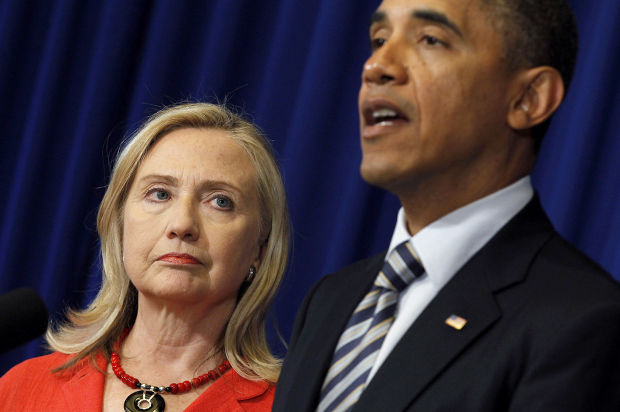Last night, the Washington Free Beacon reported that Hillary Clinton, as a 23-year-old legal intern, shared correspondences with “the late left-wing organizer Saul Alinsky,” and that these letters “reveal new details about her relationship with the controversial Chicago activist and shed light on her early ideological development.” It’s an interesting story in that it turned up previously unseen writings of a young Hillary Clinton, but it didn’t alter what anybody who cares enough to know about such things already knew: Clinton studied Alinsky’s organizing principles and was in correspondence with the man in her youth.
For conservatives, though, a story like this is of monumental importance because, to the right, “Alinsky” has become a catch-all explanation for everything Barack Obama has done as president. It’s a name that, when deployed in blog posts or debate arguments, serves as shorthand for “dangerous,” “radical,” extremist” and “leftist.”
And so when political reporters reacted to the Free Beacon story with a shrug, the right flipped into outrage mode. Here’s Mollie Hemingway at The Federalist:
The right has done a lot of journalism on Saul Alinsky’s influence of mainstream Democratic politicians such as President Barack Obama. This media coverage has been largely mocked or ignored. While conservative media outlets across the spectrum covered this influence in 2007-2008 — special recognition should go to Stanley Kurtz, who spent months digging up interesting stuff in Chicago, and David Freddoso, who also chronicled it well. Conservative reporters’ knowledge of Alinsky has helped them see when Alinsky tactics — which are ostensibly ideologically neutral — have been used on the right as well. But in 2007-2008, the mainstream media was too busy fluffing Obama or sending dozens of reporters to investigate Alaska Gov. Sarah Palin’s uterus or dig through her trash. (Remember when the Associated Press had 11 reporters fact check Sarah Palin’s book? Yeah ….)
So why does this Alinsky story matter? “Clinton’s ties to radicals are interesting because she is now running for president, obviously,” Hemingway writes.
But, again, we already know about Clinton’s ties to Alinsky. And as much as conservatives like to whine that the liberal media ignores such things, that’s just not the case. In early 2007, just as the Democratic presidential primary was getting underway, the Washington Post published a 2,300-word piece detailing both Hillary Clinton’s and Barack Obama’s links to Alinsky and his teachings. Around the same time, the New Yorker’s Ryan Lizza wrote a long profile on Obama’s career as an activist and the influence Alinsky’s teachings had on him. Both Clinton and Obama veered away from Alinsky’s rabidly anti-establishment views and decided they could do more and better work by working within the system.
When conservatives accuse the media of “ignoring” or “downplaying” the Alinsky angle, they’re really just venting frustration that reporters don’t share their habit of viewing everything liberals and Democrats do through the prism of Alinsky.
And I’m not exaggerating when I say “everything.” A quick perusal of the (recent) archives of National Review reveals that the hand of Alinsky can be found in: the 2008 Democratic convention, the administration’s Afghanistan strategy, the Justice Department’s response to the Trayvon Martin shooting, the Senate immigration reform bill, the White House’s posture toward Iran, the IRS scandal and pretty much everything else the administration does.
They start from the premise that Obama is an avatar for Alinsky’s disembodied spirit, and everything flows from there. Thus, when the president goes on the radio and says that Republicans would rather cut spending on social programs than raise taxes on the wealthy (a fairly anodyne and unquestionably true assessment of the party’s policy priorities), John Fund argues that Obama is employing “the full Alinsky,” defined as: “demonize and demagogue … opponents as a means of securing political advantage.” An average person might simply call that “politics.”
The reasoning behind this obsessive focus on characters like Alinsky and Bill Ayers and Jeremiah Wright is the firm belief among conservatives that Obama is secretly a fire-breathing leftist radical operating in the slick guise of a centrist Democrat, and if they could just make people realize this, they’d realize how “dangerous” Obama really is. People like Andrew Breitbart made it their mission to expose this “truth.” Newt Gingrich made a minor celebrity of Alinsky during his brief tenure as the front-runner for the 2012 Republican presidential nomination. The obsession with Obama’s “radicalism” was self-defeating – it did nothing to alter perceptions of him or halt his election or reelection, and only ended up making the obsessives look like fools.
Now with Clinton standing on the precipice of another presidential run, the “secret radical” strategy is being dusted off again. Stanley Kurtz, the conservative media’s most enthusiastic Alinsky dot-connector, defended the Free Beacon’s reporting by arguing that a pair of letters from the early 1970s show that Hillary Clinton was and still is a dangerous radical: “Despite her attempts to use her choice of electoral politics as evidence of distancing from Alinsky, these letters make clear that she never lost the faith.”
The letters don’t actually show that, and Clinton has a long career in public service that provides a much better accounting of her ideological development. But the right is invested in portraying Alinsky’s views as dangerous and then grafting that caricature onto today’s Democratic leaders. They’ve been doing it for years now, and all that’s kept this strategy from working thus far is that no one seems to care.

